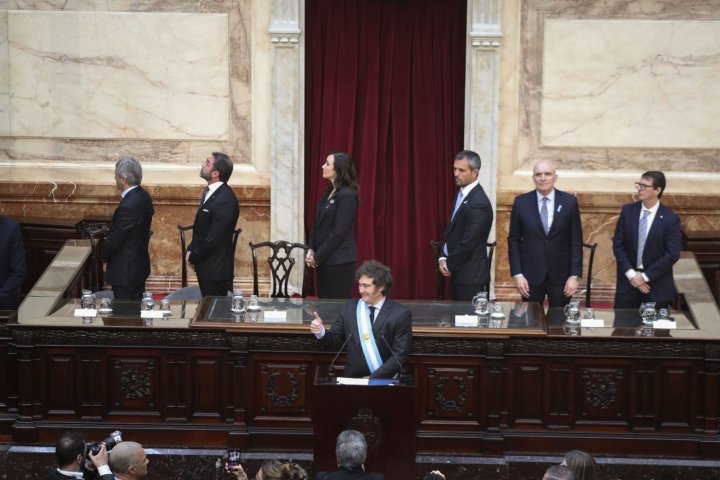
The government will seek to obtain the opinion of the 2025 Budget this Tuesday afternoon in the session of the Budget and Finance Commission, and then approve it in the session of the Chamber of Deputies next Thursday the 21st. But it is apparently the governors who are the main interested parties in its approval, trying to obtain some additional funds and relatively “secure” certain items destined for the provinces, to continue with a new extended budget that leaves the distribution of items to the total discretion of the Executive. Surrender and dedication to Milei’s plan is total.
The 2025 Budget presented by the ruling party reaffirms submission to financial capital and the IMF, and orders the entire economy as never before to pay illegitimate, illegal and fraudulent debt.
As Jésica Calcagno points out, “Better a bad budget than none at all” is the phrase that the governors and their parliamentary troops in the Deputies are making their own. The government has the support of the governors and the allied blocs of the PRO, the UCR, Federal Innovation and Pichetto Federal Meeting, which are participating in the preparation of a new text of the opinion that will only be known this Tuesday in the Commission.
The legislators who respond to the governors grant their vote to Milei’s adjustment budget in exchange for some relief from the financial suffocation to which the provinces were first subjected. They seek the co-participation of the Contributions from the National Treasury (ATN), certifications of public works, payments of the debt that the Nation has on the pension funds and other compensations.
Unión por la Patria would present with its own opinion, it will not be a rejection but it will propose an alternative economic plan. Germán Martínez listed several of the points contained in his text, some similar to the governors’ list of demands. For its part, the Left Front will present an opinion rejecting the Budget as a whole.
Keys to the 2025 Budget
Although the final text is not known, the one presented by the government on September 15 already prints the government’s main roadmap for next year. These are some of its main points:
1- Fiscal rule: In the first article, the bill establishes that “the National Public Sector must obtain, starting in fiscal year 2025 and in all subsequent fiscal years, a balanced or surplus financial result. This Fiscal Rule implies that in the event of any deviation in projected income that negatively affect the financial balance, expenses must, at least, be cut in the same proportion. To this end, items not subject to a legally established minimum execution amount must be cut in the necessary proportion in order to reestablish the financial balance. referred financial balance”. In other words, no matter what happens, the government prioritizes fraudulent debt payments, when data on the dramatic social situation that the country is going through indicates that 52.9% of the population is poor. The “fiscal rule” should be called the “law of those who have more.”
2- Debt interest: A Budget tailored to financial capital. 9% of the budget is allocated to paying debt interest to speculators and international organizations, more than $10 billion. It means more than two and a half times what goes into a university education. And 40% more than the health budget. The budget proposal says nothing about desirable objectives of ending poverty, destitution and starvation wages.
3- Fictitious projections: The ruling party projects a inflation 104.4% for 2024 and 18.3% for all of 2025. These are numbers well below the reality that is estimated to present the items in relation to a false percentage, but in this case it is almost ridiculous. Before the 2025 Budget project reaches an opinion, the INDEC reported that Accumulated inflation in the year until October 2024 reached 107%, that is, it already exceeded what the government “anticipated” just two months ago. By the end of 2025, the government estimates that the official dollar will be quoted at $1,207. This means that next year the rate of increase in the dollar will be similar to the increase in prices, something that the economic team promised for this year, but is not achieving.
4- The brutal fiscal adjustment crystallizes: The adjustment of expenditure items excluding the payment of debt interest is of the order of 29% in real terms between 2023 and 2025. The main cuts are given by Economic Services (-56% compared to 2023), which implies more rates and different social services such as Promotion and Social Assistance (-61% vs 2023), Education and Culture (-44% compared to 2023 ), Science and Technology (-32%), Housing and Urban Planning (-51%), Potable water and sewage (-66%), Social Security (retirements, pensions, family allowances, – 16%).
5- Increase in tax regressivity:T ax pressure will increase from 22.37% of GDP in 2024 to 22.92% next year, a striking increase considering that President Javier Milei referred to taxes as theft. This increase in pressure is unequal and regressive: a greater burden is projected on workers through an increase in the collection of the Income Tax and the Monotax while reducing the expected income from Personal Assets. Meanwhile, tax spending is maintained, that is, what the State stops collecting for benefits achieved, fundamentally, by large businessmen (Galperin with the Knowledge Economy Law, Tierra del Fuego regimes, mining activity), among others. In 2025 it will represent 3.54% of GDP.
6- More adjustment to retirees and pensioners: The amount allocated to retirements and pensions in 2025 falls 10.4% compared to 2023 and 3% compared to 2024, considering REM-BCRA inflation. For the pension benefits budget to have the same purchasing power as in 2023, it should be $42.3 billion and it is only $38.6. That is, $3.7 billion pesos less. This cut represents almost a third of what is intended to be allocated to debt interest to private individuals and international organizations in 2025 (10 trillion pesos).
7- Cuts in Health: The budget assigned to the Ministry of Health will be reduced by 23% in real terms in 2025 compared to 2024. The adjustment that many of the Public Hospitals and most recognized institutions will suffer, which serve thousands of working families daily and that in many Sometimes they carry out highly complex treatments and operations. Almost all hospitals have cuts greater than 15%. The Bonaparte Hospital will have 30% less resources in real terms than in 2023 and -10% than in 2024, Posadas and Garrahan, 11.5% less than in 2023. The National Cancer Institute is given 50% less than in 2023 Likewise, key programs such as “Access to medicines, supplies and medical technology” are cut.
8- Attack on education and public universities: The Budget project suspends legal floors of budgetary guarantees in Education (6% of GDP) and Science and Technology (0.39% of GDP by 2024 and its growth until reaching financing equal to 1% of GDP by 2032). The obligation to comply with the financing floor of 0.2% of total current income for Professional Technical Education is also eliminated. For Universities, the real cut between 2023 and 2025 will be 36.7%.
9- Chainsaw to environmental funds: The government fails to comply with the Forest Law and only allocates 38.8 times less to the National Enrichment and Conservation Fund than it should allocate. From another perspective, it only allocates 2.56% of what it should receive by law. In addition, the Federal Fire Management System will go from receiving $33,338 million to $28,603 million to prevent fires, which means less than 0.025% of the total budget. It also eliminates programs and allocations for the development of renewable energies.
10- Dismantling of gender items: The Accompany Program is at a very high risk level; Of the 20 thousand discharges scheduled for the first quarter of 2024, only 434 women and LGBT people were reached. Last year, for the first quarter of 2023, the program was granted to 34 thousand people, while in this first quarter it was granted to 434. Overall, its execution was reduced by 79%. The Protection and Rescue Programs for victims of violence and trafficking registered drops of 72.11% and 90% in the same period. The budget items for Comprehensive Sexual Education (Law 26,150, of 2006) are directly eliminated, which establishes that students have the right to receive ESI in public, state-managed and private educational establishments throughout the country, it is not directly contemplate. The specific items intended to provide urgent help to trans people or hormonal treatment and training for that population do not appear in the project annexes either.
11- High rates: looting of the pocket and celebration of profits: The high rates of public services are deepening, which constitute one of the main mechanisms of the ongoing salary plundering. Subsidies to the energy sector decreased by 41.7% year-on-year (from $6,741,332 million to $5,040,403 million) while funds allocated to Transportation increased by 30% real year-on-year (from $2,369,729 to $3,948,073 million). The budget foresees that 84.83% of the wholesale costs of the electrical system will be covered by the electricity rate paid by users, “each of them with different rate treatments.” An increase of 20 percentage points compared to 2024 that would impact an increase in the rate.
Source: www.laizquierdadiario.com

